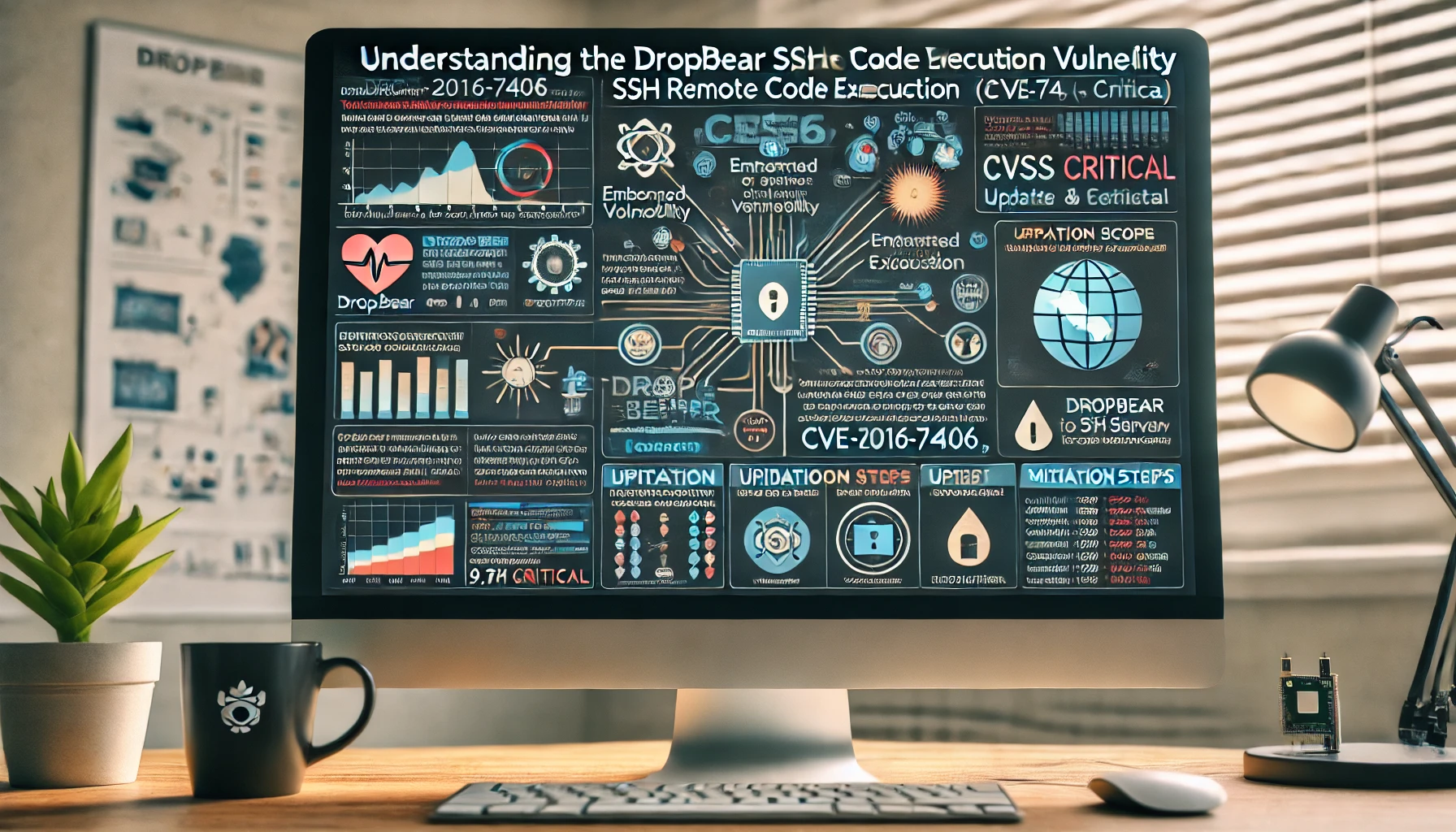Dropbear SSH CVE-2016-7406: A Guide to the Remote Code Execution Vulnerability
 Chimere Anyiam
Chimere Anyiam
Introduction
The Dropbear SSH Remote Code Execution vulnerability (CVE-2016-7406) has significant implications for systems that rely on this lightweight SSH server and client software. Commonly used in embedded systems and IoT devices, Dropbear SSH's compact nature makes it a popular choice for environments with limited resources. However, vulnerabilities like CVE-2016-7406 highlight the critical need for regular updates and security vigilance.
What is Dropbear SSH?
Dropbear is an SSH server and client designed to be lightweight, making it suitable for embedded systems, routers, and IoT devices. Its small footprint and efficiency are key factors in its widespread adoption.
CVE-2016-7406: The Vulnerability
CVE-2016-7406 is a remote code execution vulnerability affecting Dropbear SSH versions before 2016.74. This vulnerability is due to improper handling of format string specifiers in the (1) username or (2) host arguments, which allows remote attackers to execute arbitrary code.
The vulnerability exists because Dropbear SSH does not properly sanitize input, which could be exploited by an attacker to inject malicious code. This vulnerability is critical because it can lead to unauthorized access and potential control over affected systems.
Exploitation and Impact
An attacker can exploit CVE-2016-7406 by crafting a malicious SSH URL containing specific format string specifiers. When a user interacts with this URL, the Dropbear SSH client processes it, allowing the attacker to execute arbitrary code. This can lead to severe consequences, such as data breaches, unauthorized access, and control over compromised devices.
The vulnerability is particularly dangerous for embedded systems and IoT devices, which often have limited security measures in place and can serve as entry points for further attacks on a network.
CVSS Scores and Severity
According to the National Vulnerability Database (NVD), CVE-2016-7406 has a CVSS v3.0 base score of 9.8 (Critical), with the following vector:
CVSS:3.0/AV:N/AC:L/PR:N/UI:N/S:U/C:H/I:H/A:H
This indicates that the vulnerability is easily exploitable, requires no privileges, and can significantly impact confidentiality, integrity, and availability (NVD) (NVD).
Mitigation and Patching
To mitigate the risk posed by CVE-2016-7406, it is essential to update Dropbear SSH to version 2016.74 or later. The updated version includes fixes that address the improper handling of format string specifiers, effectively closing the security gap.
Administrators are advised to:
Update Dropbear: Ensure all instances are updated to the latest version to patch the vulnerability.
Implement Monitoring: Use monitoring tools to detect unusual SSH connection attempts and potential exploitation activities.
Educate Users: Inform users about the risks of interacting with untrusted SSH URLs and the importance of verifying SSH server authenticity.
Conclusion
CVE-2016-7406 underscores the importance of maintaining updated software and staying vigilant about potential security flaws, especially in systems that rely on secure remote access. Understanding and addressing this vulnerability is crucial to protecting systems from unauthorized access and potential exploitation.
By following the recommended mitigation steps and staying informed about the latest security updates, organizations can enhance their cybersecurity posture and safeguard their systems against emerging threats.
Subscribe to my newsletter
Read articles from Chimere Anyiam directly inside your inbox. Subscribe to the newsletter, and don't miss out.
Written by

Chimere Anyiam
Chimere Anyiam
With a robust background in IT support and cybersecurity, I have over seven years of experience in technical support, system administration, and cybersecurity. I have a proven track record of improving system performance, securing digital landscapes, and providing excellent user support. My commitment to continuous improvement and leveraging advanced monitoring techniques drives my dedication to advancing organizational security and user support.